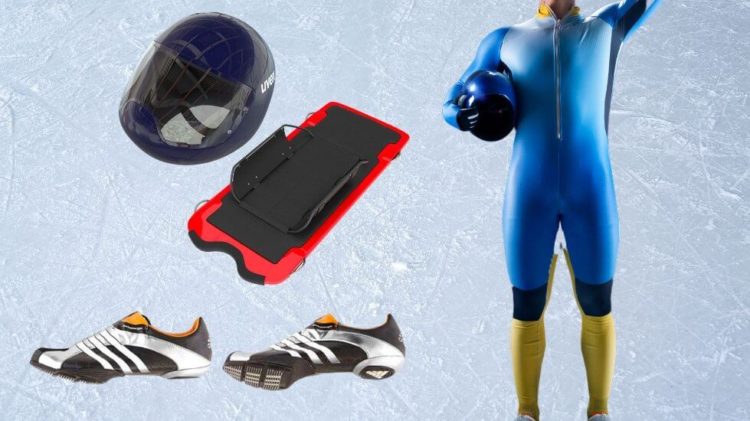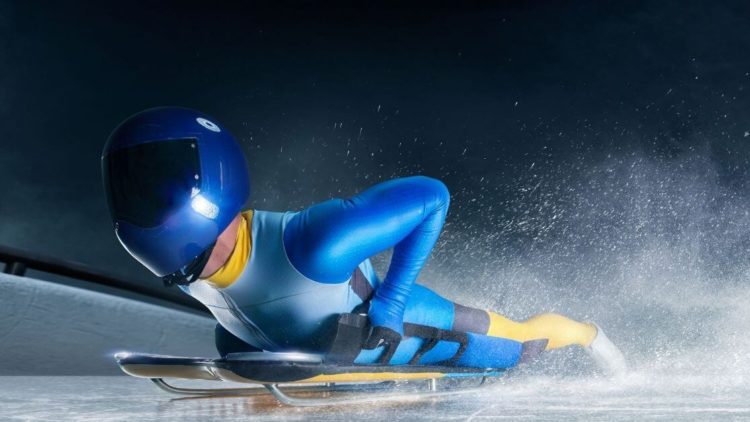
OBJECTIVE OF SKELETON: Reach the finish line at the end of the track in the least amount of time possible.
NUMBER OF PLAYERS: 1+ player(s)
MATERIALS: Olympic Skeleton sled, helmet, bodysuit, spiked shoes
TYPE OF GAME: Sport
AUDIENCE: 13+
OVERVIEW OF SKELETON
Skeleton is an Olympic winter sport in which competitors race down an icy track on a small sled. This sport is very similar to luge, although skeleton sees athletes race facedown and head-first down the track instead of on their back, feet-first.
Where did the Olympic Skeleton originate? It can be traced back to 1882 when English soldiers constructed various toboggan tracks between towns in Switzerland. While there is no definitive answer as to why the sport is named skeleton, it is thought that the name is derived from either the sled’s bony appearance or a poor translation of the Norwegian word for a sled or toboggan,”kjelke”. The first Austrian skeleton championships were held in 1906, and the Skeleton Federation was formed in 1923.
Despite its late 19th-century origin, skeleton didn’t become a well-established Olympic sport until the 2002 Olympic Winter Games in Salt Lake City, Utah, where it has remained an Olympic sport ever since. Before the 2002 Olympics, skeleton had only been featured in the 1928 and 1948 Olympic Winter Games. It is thought that the sport’s 54-year Olympic absence was a result of inadequate popularity, as the sport didn’t even host an annual World Championship until the minimum requirement of twelve competing countries was finally reached in 1987.
SETUP

EQUIPMENT
- Sled: A skeleton bobsled ranges in length from 31.5 inches to 47.2 inches, depending on the height of the athlete. This sled is constructed of solid steel and can weigh up to 95 pounds for male athletes and 77 pounds for competing women. Similar to a luge sled, a skeleton sled features two long steel runners underneath and bumpers/handles on the sides to help secure the athlete.
- Helmet: Competitors must wear an alpine racing helmet with a face shield to protect their entire head.
- Bodysuit: As with all other winter sled sports, skeleton athletes must wear an aerodynamic suit designed to minimize drag forces while also protecting their skin from possible ice burn.
- Spiked shoes: Shoes equipped with metal spikes are necessary for traction while sprinting on the ice at the start of a run.
EVENTS
Unlike the other winter sled sports of bobsled and luge, skeleton has traditionally only featured single-rider events. However, as of June 2022, the International Olympic Committee decided to include a new mixed-team event in the 2026 Winter Olympic Games in Milano-Cortina.
This mixed-team event is very similar to the mixed-team relay seen in the sport of luge. One Women’s Skeleton racers will take their run down the track, with their finish marking the start of the subsequent male athlete’s run. Both Olympic Skeleton racers’ times are combined and compared to the rest of the field.
THE TRACK
At the Winter Olympics , all skeleton events take place on the same track as both luge and bobsled events. These tracks usually measure a mile in length, contain fifteen or more turns, and descend close to 400 feet from start to finish.
As an example of such a track, at the 2022 Beijing Olympic Winter Games, for the Olympic sport Skeleton Competition the “Snow Dragon” sledding track featured 16 total curves, measured 1.6 miles in length, contained a 397-foot elevation difference from start to finish, and even had an extremely rare 360-degree turn!
GAMEPLAY

A skeleton run begins in the same fashion as a bobsled run – athletes push their sled to generate as much speed as possible before hopping onto the sled on their stomach for the remainder of the run. This running start on the ice is made possible by the traction provided by the spiked shoes, allowing them to sprint at full speed with little worry of slipping on the ice.
HEATS
Skeleton competitors are given four total runs spread out across two separate days. All four of these run times are then combined into a final time that is used to determine the rankings of the event.
Each skeleton run is timed to hundredths of a second, with these minuscule margins often narrowly separating the top sledders.
HOW SKELETON SLEDS ARE STEERED
For the unknowledgeable viewer, it is commonly thought that skeleton sleds are simply controlled by fate – that is, the sledder has basically no control over where their sled is headed other than simply down. While it is true that skeleton sleds have no steering or braking mechanisms, an athlete can control the sled entirely with their own body.
Similar to luge, a skeleton athlete uses their entire body to control the sled. However, as a skeleton run is done head-first and in a prone position, this changes the overall body mechanics used to steer.
While shifting body weight is still a major aspect of steering a skeleton sled, possibly the most important tool at an athlete’s disposal is their head and shoulders, which lead them down the track. By turning their head and pushing down on the corners of the sled with their shoulders, a sledder can make minor adjustments that make a world of difference in how the sled maneuvers around curves. Likewise, athletes can push on the corners of their sled with their knees and tap the ground with their toes to alter their trajectory.
As the skeleton sleds slide down the track, athletes can easily reach speeds over 80 miles an hour, making it one of the most dangerous Olympic sports, up there with bobsled and luge, though Skeleton races tend to be the slowest.
Check out how fast these skeleton sliders go in these Skeleton event highlights:
Skeleton – Men’s Heats 1 & 2 | Sochi 2014 Winter Olympics
END OF GAME
As with all other racing events, the Skeleton athlete races to have the fastest combined time of their four runs. They are the winner of the skeleton race.
- 30 GAMES TO PLAY OVER TEXT - April 22, 2024
- 20+ FREE PRINTABLE BABY SHOWER GAMES - April 16, 2024
- 20+ College Party Games for the Best Night Ever! - April 2, 2024